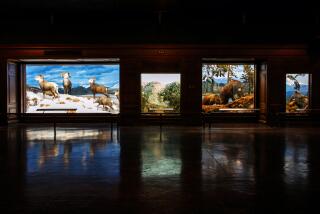Artist Sets Up Her Easel in a Biological World
- Share via
When illustrator Frances Runyan of Agua Dulce looks at a leaf, she sees more than its almond shape and green color. She studies its veins, feels its texture, gauges its strength.
Runyan, 73, a white-haired grandmother of four, is a self-taught artist whose pencil and watercolor drawings of plant, insect and marine life--showing every serration, antenna and scale--are on display at the Los Angeles County Museum of Natural History.
From Runyan’s first project in 1940--a series of prize-winning drawings for the Cactus and Succulent Society--her illustrations have traveled widely. Her works are in private collections and in institutions such as the Hunt Institute for Botanical Documentation at Carnegie-Mellon University in Pittsburgh, Pa. She has illustrated scientific journals and books such as “Narcotic Plants” by William Emboden, professor of biology at California State University, Northridge.
Yet Runyan has had no special training as an illustrator. “I just sat down and did it. It was just that simple,” she said. “Although, at first, I didn’t know anything about the scientific side of it. I would just do buildings and scenes and some plants.”
She studies a subject thoroughly before beginning to draw and has a reputation for exactness.
“It has to be that way for research,” she said. “If it isn’t a good drawing, it isn’t any good for research.”
As she draws, she peers frequently into a microscope--a necessary tool for drawing subjects that may be only a millimeter in length.
Researching and drawing a plant usually takes 50 hours. An isopod, or crustacean, takes about 60 hours. But it’s not unusual for Runyan to spend up to 85 hours on a drawing. She often works late at night and, sometimes, into the morning at her home studio.
The road to her home curves gently around a mountainside before dipping into a verdant valley. The small house is surrounded by nearly 200 varieties of plants and flowers on its half-acre site.
“This is neat,” she said, “because I could have a garden, which I experiment with a lot and use for my illustrating and for teaching.”
Runyan moved from Northridge to Agua Dulce for the solitude. “There were too many barking dogs, and I got tired of that. Instead of dogs and cats, I have mallards and birds and lizards.”
Twice weekly, she packs art gear into her green 1972 Chevelle Malibu (“I treat it like a piece of china”) and makes the 104-mile round trip to the Natural History Museum. There, she often uses a 1,000-power magnification microscope to finish drawings of tiny isopods.
“It has to be a pretty high-powered microscope to do the finishing, to see all the little spines and hairs,” she said.
“I don’t use a grid. Most of the time I do things by eye. I’ve learned to do it so it is extremely exact that way,” she said. “I just draw the animal as it is and compare it so it’s exact, then enlarge it. It takes practice.”
She has been teaching an evening course in biological illustration for six of the 23 years she has volunteered as a docent at the museum. In the museum’s basement, students from 18 to 65 attend the twice-yearly course.
Her students take the class for a variety of reasons. For some, it is simple relaxation; others plan to enter scientific illustration as a business or use its techniques in an existing business.
“One lady wanted to incorporate it into her lamps. She was making leaded Tiffany lamps,” Runyan said.
Stippling, a technique of painting or drawing many black dots to effect a line or shaded area, is part of what Runyan teaches. She also teaches line illustration, which she calls “a little more difficult because you can’t do as much with it as you can with stippling.”
What Runyan doesn’t teach is a technique that has become as personal as her signature.
She devised a way to combine colored, waterproof pencil with watercolor paint on paper designed for black ink only. With it, she is able to achieve fine detail and varied textures such as a smooth, shiny surface on a leaf.
“It took me two or three years to really develop it,” she said. “It gives a certain look. If you work hard and you learn how, you can do an awful lot with color, even watercolor.”
Runyan, who did not attend college or art school, says of her talent: “You are either born or you’re not with a natural ability. And I was lucky, too.”
When she began her career as an artist and illustrator, she said, many people doubted she could earn a living.
“So I said, ‘I’m going to.’ It’s very hard. You have to work full time.”
Rather than contemplating retirement, Runyan is considering additional career goals, including mass producing her illustrations as prints and posters and drawing a series of spiders, especially those too tiny to be seen with the naked eye.
“They’re beautiful when you magnify them,” she said.
“The Art of Biological Illustration” is on display in the Director’s Gallery at the Museum of Natural History through Aug. 16.






